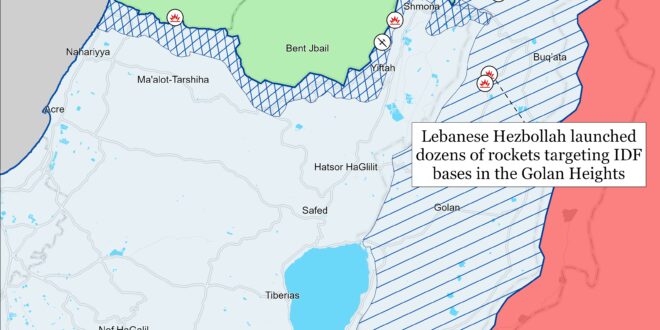Israel withdrew most of its forces from the Gaza Strip on April 7. Israeli officials and media sources have framed the withdrawals as part of their preparations for conducting a clearing operation into Rafah. Israeli Defense Minister Yoav Gallant announced on April 7 that Israeli “forces came out” of the Gaza Strip “and are preparing for future missions” into Rafah.[i] Israeli military correspondents similarly interpreted the withdrawal as part of an IDF effort to reconstitute ahead of advancing into Rafah.[ii] Israeli media close to the Israel Defense Forces (IDF) clarified that the IDF 98th Division withdrew from the southern Gaza Strip on April 7.[iii] Israeli brigades and units operating under the command of the 98th Division were previously the only Israeli forces remaining in the southern Gaza Strip. Palestinian sources posted images of areas in which the 98th Division recently operated, suggesting that Israeli forces had withdrawn from those areas.[iv]
Hamas and other Palestinian militias will likely try to exploit the Israeli withdrawal to reconstitute militarily and reassert Hamas governing authority around Khan Younis. Israeli officials and media sources have framed the withdrawals as part of their transition toward a raid-based model around Khan Younis—similar to what the IDF has done in the northern Gaza Strip since December 2023.[v] Israeli military correspondents asserted that the IDF has destroyed Hamas’ Khan Younis Brigade and will accordingly transition to conducting raids to target remaining militia forces and infrastructure there.[vi] Hamas conducted a multi-stage attack that killed four Israeli soldiers in Khan Younis on April 6, however, demonstrating that Hamas retains some combat effectiveness there.[vii] CTP-ISW has reported extensively on how Hamas and other Palestinian militias have exploited the withdrawal of Israeli forces in the northern Gaza Strip to infiltrate and rebuild their networks there.[viii] The IDF has redeployed to several areas in the northern Gaza Strip in recent months to re-clear those areas of Palestinian fighters and militia infrastructure.[ix] Hamas and the other Palestinian militias will likely see an opportunity to pursue similar effects around Khan Younis following the Israeli withdrawal there.
Unspecified Israeli sources claimed that the IDF withdrawal from the southern Gaza Strip will enable displaced Palestinians in Rafah to migrate to parts of Khan Younis and the central Gaza Strip.[x] The migration of Palestinians from Rafah to other parts of the Gaza Strip would facilitate an Israeli clearing operation into Rafah, according to Israeli military correspondents.[xi] Israel and aid organizations have not yet constructed encampments in the southern and central Gaza Strip to which Gazans could migrate. Israeli media indicated that the construction of such encampments was part of the IDF humanitarian plan.[xii]
The withdrawal of the IDF 98th Division means that the Nahal Brigade is the only remaining Israeli unit in the Gaza Strip.[xiii] The Nahal Brigade operates around the border of the central and northern Strip to secure Israeli-built highway Route 749, which bisects the northern and southern Gaza Strip and three nearby forward operating bases for future raids and operations in the Gaza Strip.[xiv] The role of the Nahal Brigade in securing the divide between the central and northern Gaza Strip is consistent with the IDF’s full transition to a raid-based model. Israeli military correspondents have reported that the IDF uses the road to quickly launch raids into the Gaza Strip, such as the al Shifa Hospital operation that the IDF chief of staff called a ”great achievement” for leading to the capture and death of many senior Hamas and Palestinian Islamic Jihad (PIJ) fighters on March 30.[xv]
Key Takeaways:
- Gaza Strip: Israel withdrew most of its forces from the Gaza Strip. Israeli officials and media sources have framed the withdrawals as part of their preparations for conducting a clearing operation into Rafah. Hamas and other Palestinian militias will likely try to exploit the Israeli withdrawal to reconstitute militarily and reassert Hamas governing authority around Khan Younis.
- West Bank: Israeli forces have engaged Palestinian fighters in at least four locations in the West Bank.
- Southern Lebanon and Golan Heights: Lebanese Hezbollah has conducted at least seven attacks from southern Lebanon into northern Israel.
- Iraq: The Islamic Resistance in Iraq claimed that it conducted a drone attack targeting an unspecified “vital target” in Eilat, Israel.
- Yemen: The Houthis claimed that they conducted five drone and missile attacks targeting civilian and military vessels over the previous 72 hours.
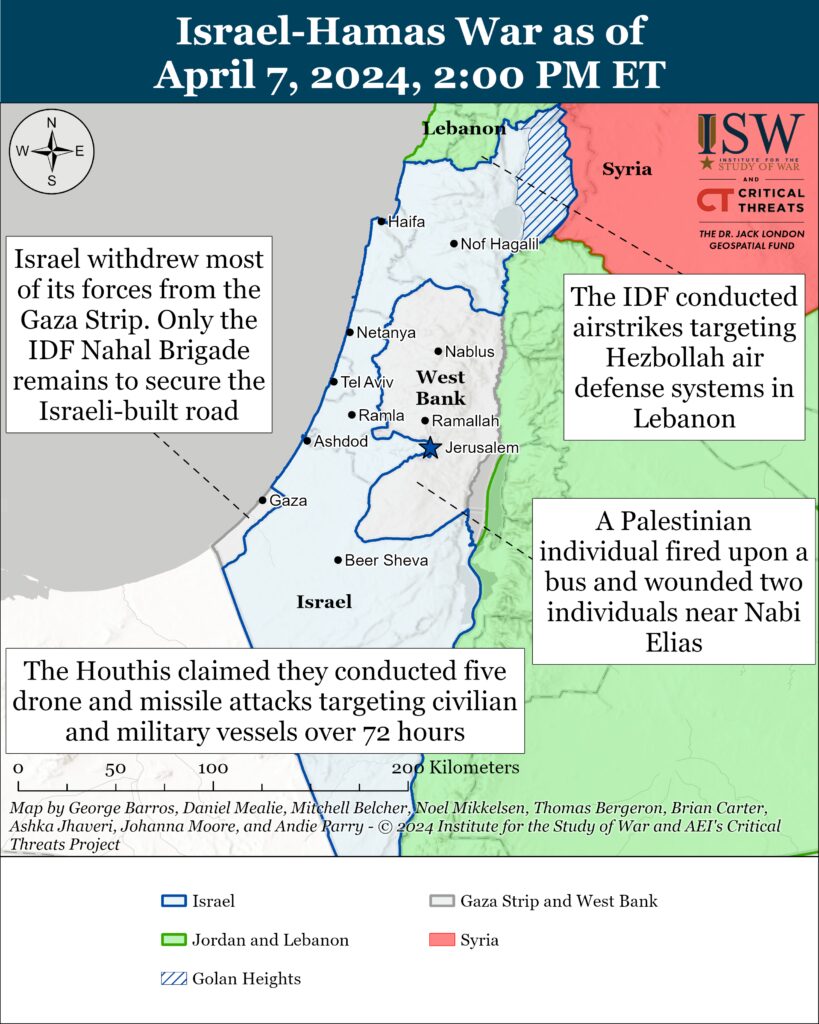
Gaza Strip
Axis of Resistance objectives:
Erode the will of the Israeli political establishment and public to sustain clearing operations in the Gaza Strip
Reestablish Hamas as the governing authority in the Gaza StripThe IDF 89th Commando Forces (98th Division) cleared al Amal neighborhood, western Khan Younis, before withdrawing on April 7. The 89th Commando forces located over 100 militia sites during operations in al Amal.[xvi] Israeli forces detonated and destroyed a 900-meter tunnel equipped with living rooms and weapons stores.[xvii] The IDF conducted raids to seize weapons and kill Palestinian fighters, including a Hamas squad commander.[xviii]
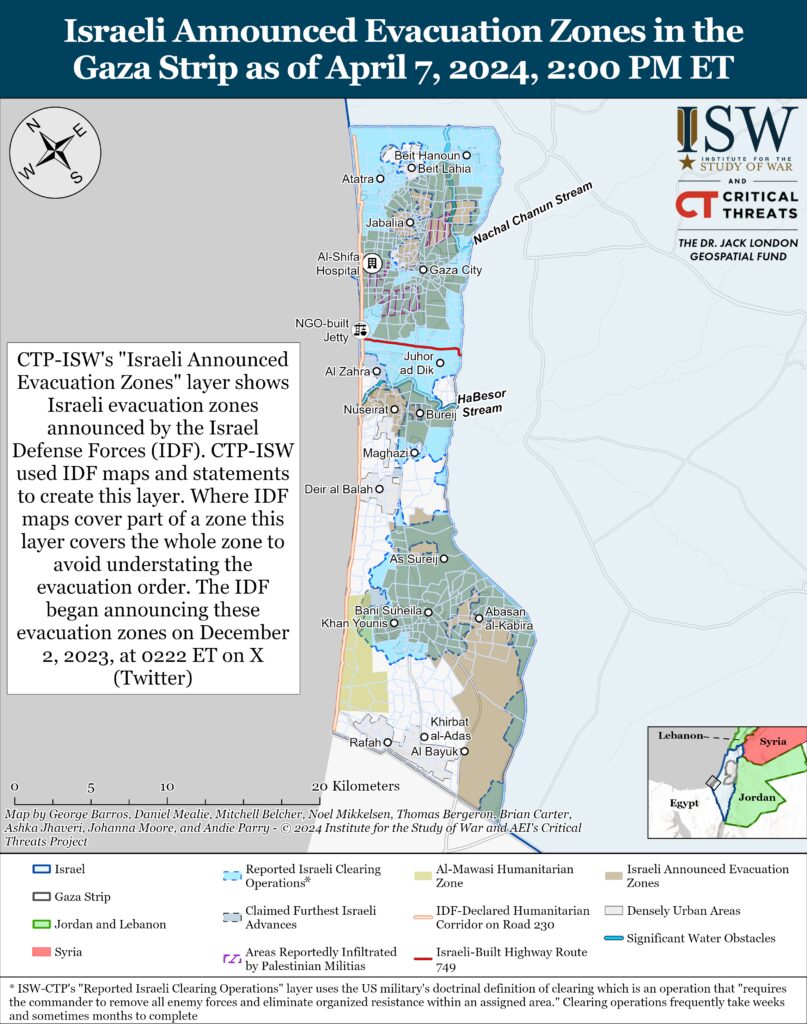
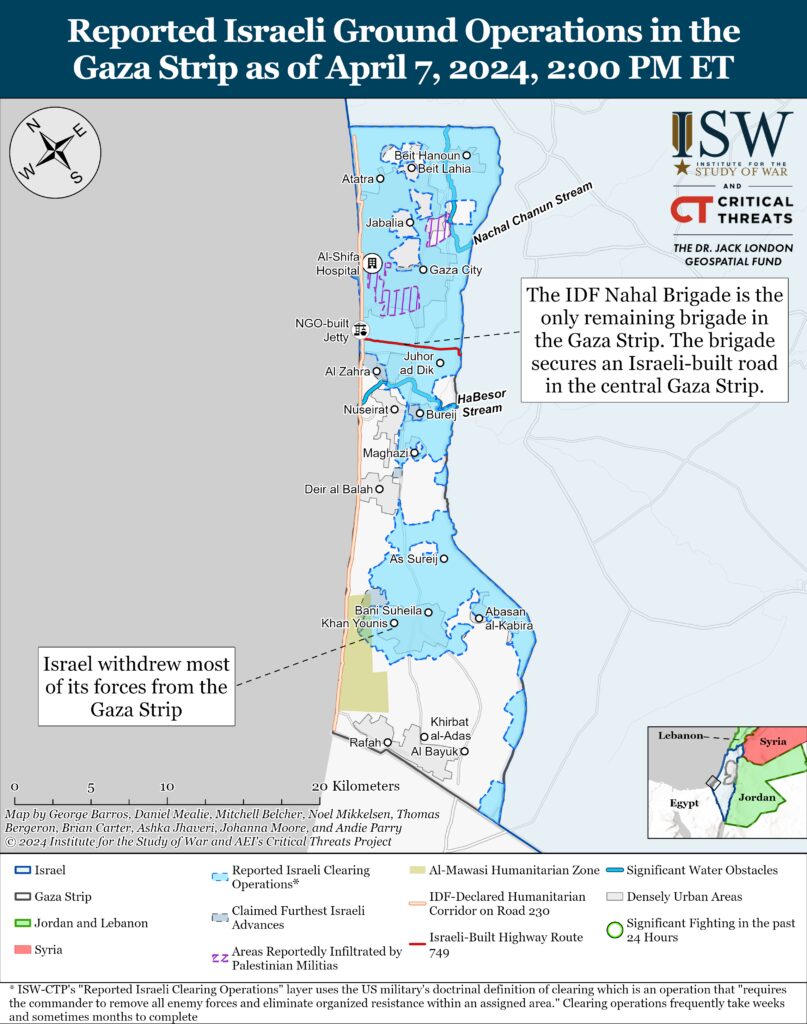
Palestinian fighters conducted two indirect fire attacks from the Gaza Strip into Israel on April 7. PIJ targeted towns in southern Israeli with a five-rocket barrage shortly after all Israeli forces withdrew from the southern Gaza Strip.[xix] An Israeli military correspondent said that the Iron Dome intercepted all the rockets.[xx] The Palestinian Mujahideen Movement separately targeted the IDF Gaza Division headquarters in Reim, southern Israel.[xxi]
The Democratic Front for the Liberation of Palestine mortared Israeli armor near the Israel-Gaza Strip border northeast of Qarara on April 7.[xxii] Palestinian militias did not claim additional attacks targeting Israeli forces on April 7, likely due to the IDF withdrawal from the southern Gaza Strip and a lack of target availability.

West Bank
Axis of Resistance objectives:
Establish the West Bank as a viable front against IsraelIsraeli forces have engaged Palestinian fighters in at least four locations in the West Bank since CTP-ISW’s last data cut off on April 6.[xxiii]
A Palestinian fighter fired upon an Israeli bus and wounded two individuals, including an IDF soldier, near Nabi Elias on April 7.[xxiv]
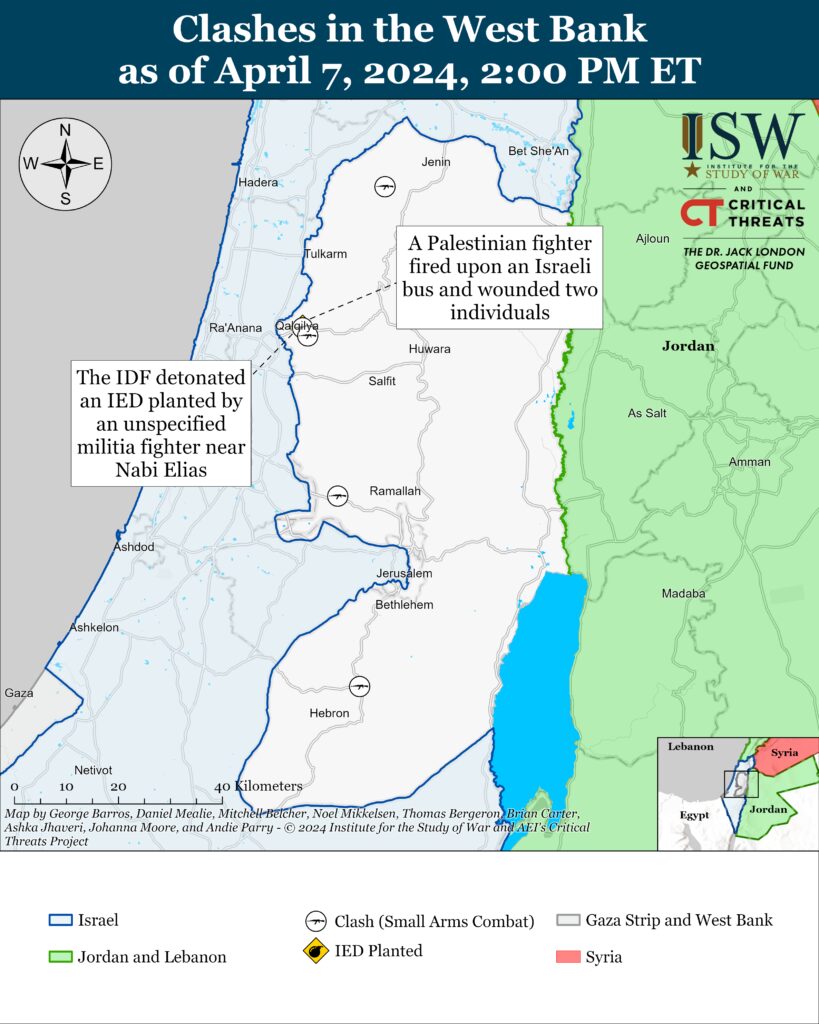
This map is not an exhaustive depiction of clashes and demonstrations in the West Bank.
Southern Lebanon and Golan Heights
Axis of Resistance objectives:
Deter Israel from conducting a ground operation into Lebanon
Prepare for an expanded and protracted conflict with Israel in the near term
Expel the United States from SyriaLebanese Hezbollah has conducted at least seven attacks from southern Lebanon into northern Israel since CTP-ISW’s last data cutoff on April 6.[xxv]
The IDF conducted airstrikes targeting Hezbollah air defense systems in Baalbek, Lebanon, after Hezbollah intercepted an IDF drone over southern Lebanon on April 6.[xxvi]
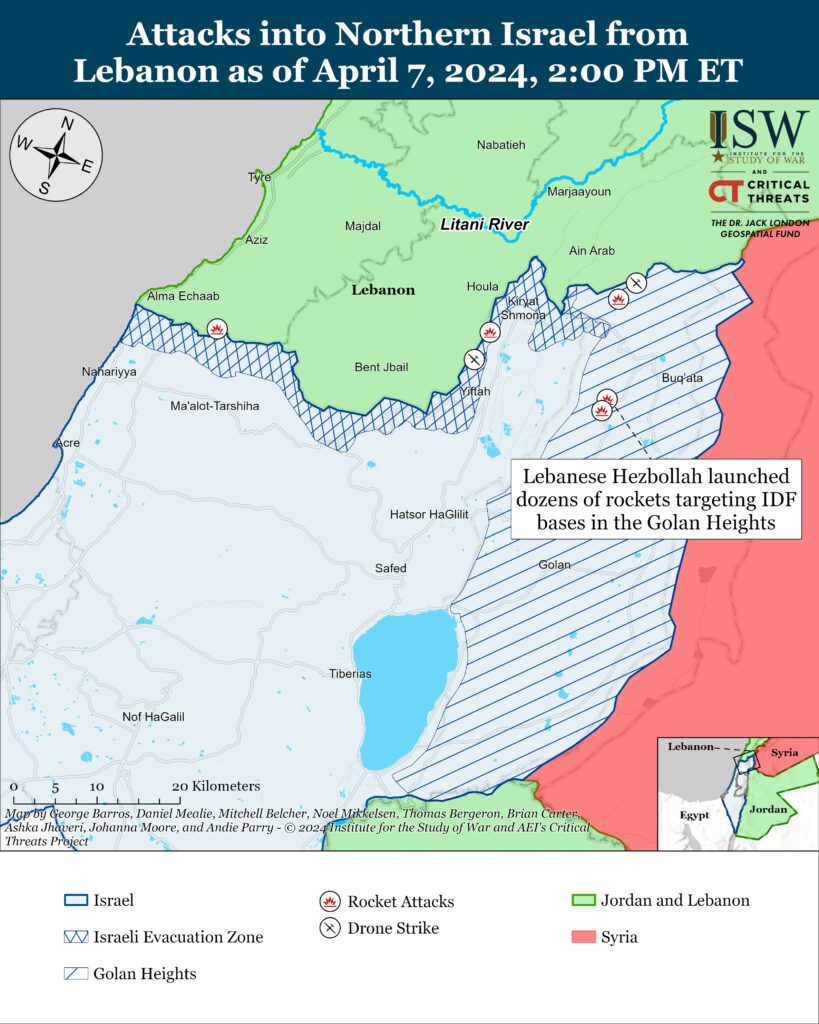
Recorded reports of attacks; CTP-ISW cannot independently verify impact.
Iran and Axis of Resistance
The Islamic Resistance in Iraq—a coalition of Iranian-backed Iraqi militias—claimed that it conducted a drone attack targeting an unspecified “vital target” in Eilat, Israel, on April 6.[xxvii] Israel media reported on April 7 that “hostile aircraft intrusion sirens” went off in Eilat.[xxviii] The IDF later announced that these sirens were a “false alarm.”[xxix]
The Houthis claimed on April 7 that they conducted five drone and missile attacks targeting civilian and military vessels over the previous 72 hours.[xxx] The Houthis claimed that they conducted anti-ship missile attacks targeting a Marshall Islands-flagged “British ship” in the Red Sea and two Panamanian-flagged “Israeli ships” in the Arabian Sea and Indian Ocean.[xxxi]
The United Kingdom Maritime Trade Operations (UKMTO) reported that international coalition forces intercepted a missile and that a second missile fell into the water near a vessel approximately 60 nautical miles southwest of Hudaydah, Yemen, on April 6.[xxxii] US Central Command (CENTCOM) confirmed that a coalition vessel engaged and destroyed an anti-ship missile on April 6.[xxxiii] UKMTO separately reported that a missile impacted the water near a vessel approximately 59 nautical miles southwest of Aden, Yemen, on April 6.[xxxiv]
The Houthis also claimed that they conducted two drone attacks targeting unspecified US “military frigates” in the Red Sea.[xxxv] CENTCOM announced that it intercepted a Houthi drone over the Red Sea on April 6.[xxxvi]
US Central Command (CENTCOM) destroyed a mobile, surface-to-air missile in Houthi-controlled territory in Yemen on April 6.[xxxvii]

 Eurasia Press & News
Eurasia Press & News
